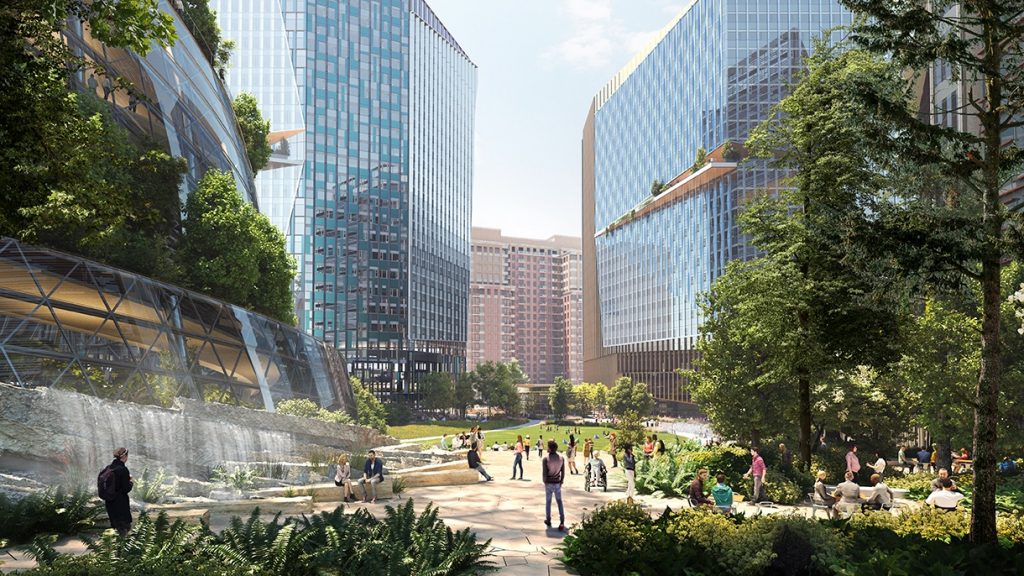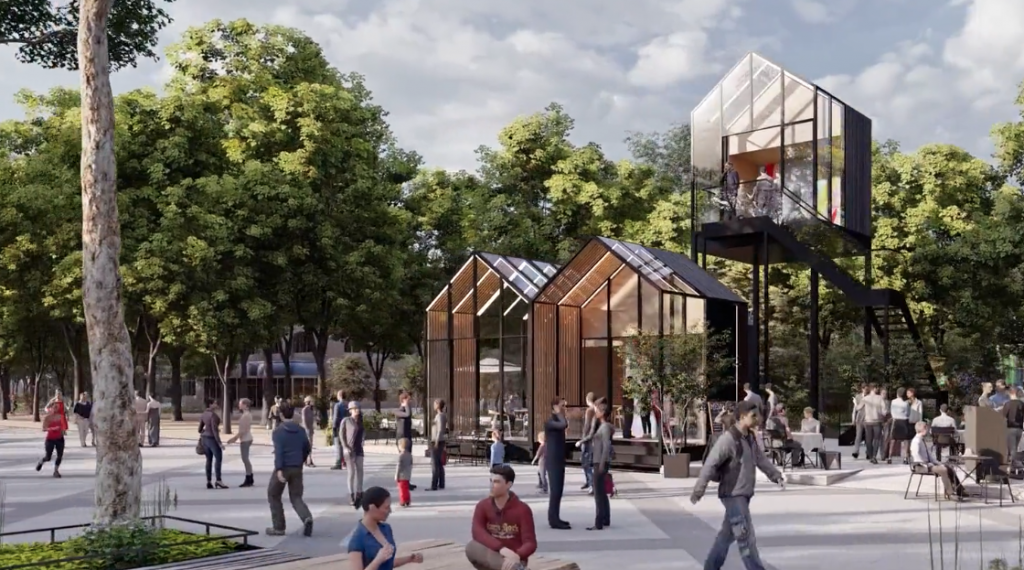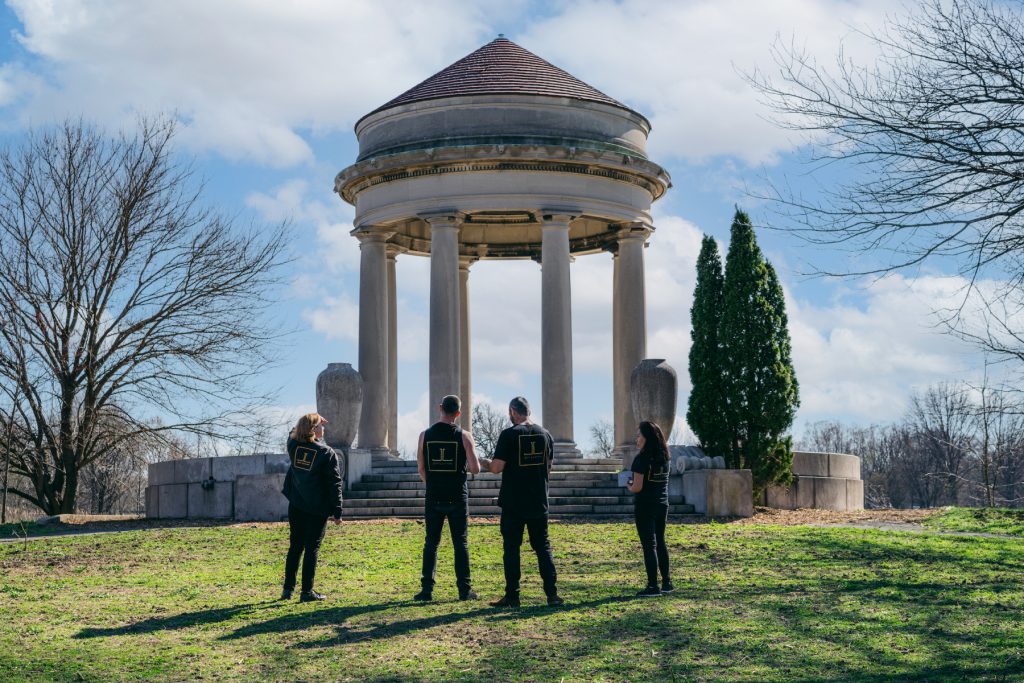Habitat is a word much in use today and has come to mean many things, but one of its earliest descriptions, according to the Oxford English Dictionary, was in 1796 when it was defined as “the natural place of growth of a plant or animal in its wild state. This is now generally expressed as the word Habitat.” Take plant out of its habitat, and special measures must be taken to secure its survival…and so we have greenhouses and conservatories. And for us humans, the entire earth is our habitat, but take us out of it – or let it wither – and then what? Will we be confined to living in glass houses, too, like orchids or lemon trees forced to grow beyond the tropical zone? I, for one, don’t much fancy life as a hot-house flower.
Landscape designers and their architect partners have brought the notion of habitat into their conversations, reframing our world by taking their leit motif from the flora and fauna with which we share it. The prevalent trend for public spaces appears to be using glass to shatter boundaries between indoors and outdoors, which may explain the current popularity for mid-20th-century modernist design, the time when plate glass became widely available.
Glass cubes in urban centers are giving way to innovative corporate conservatories that message a corporations ideologies and inclusiveness: Amazon’s HQ2 proposal for its east coast headquarters in Arlington, Virginia is just that: instead of reaching for the sky with overbearing towers, they’ve chosen a glass spiral modeled after the double helix–the foundation of life’s DNA, a the form of everything from seashells to galaxies, to our very being.
The Helix complex is a natural extension of The Sphere, Amazon’s Seattle, Washington HQ, which takes biophilia — our need for nature — as it starting point. The Helix, as described by Amazon, is geared to promote, “a strong connection with the local community. We believe that campuses should be neighborhoods that bring people together and not isolated, employee-only spaces that ignore their surroundings.” To that end, the main structure of the three office buildings is a true double helix with exterior walking paths winding through a landscaped terrain, with the whole complex integrated into an urban forest. Public access will be encouraged.

When Andre Le Notre created the extravagant formal gardens at Versailles in 1661, he did so to imprint the natural landscape with idea of man’s dominion over nature, and man in this instance being The Sun King, Louis XIV. In 1667, Le Notre planned an extension of the gardens of the Tuileries Palace that later became the Champs Élysées, the broad avenue connecting the Place de la Concorde (where Marie Antionette was guillotined) with the Arc de Triomphe. Ever the high fashion influencer, Paris has undertaken to transform the historic tree-lined, high-end, shopping concourse, choked with cars across eight lanes, and thick with tourists, into an urban forest and pedestrian- friendly public space that will encourage locals to reclaim the heart of the city; it’s proposed to complete the revolutionary transformation by 2030.
As PCA-Stream, the studio of architect Philippe Chiambarreta, that is heading the project announced, “the Champs-Élysées district deserves to shine again as a demonstrator of a new approach to the city focused on nature and well-being, a more sustainable, inclusive and desirable city.” This will be achieved by resurfacing the road to be low-noise, dotting the concourse with food kiosks and cafés, and installing “planted living rooms” as gathering places. This calls to mind the Parc Andre Citroen, designed by Gilles Clement and built nearly thirty years ago. Its purpose was to fill a brown site on the Left Bank where the Citroen car factory once stood and serve as a buffer zone between the country and the city… where rus meets erbe, and where local people could once again connect with their habitat. Visiting it as I did in not long after its opening, was a revelation of how a public park can be so much more than a “green space.”

Closer to home, the annual Philadelphia Flower Show has gone through some ups and downs over the years, yet retains its mantel as America’s Flower Show. Previous years’ shows were held at the tail end of winter, indoors beneath artificial lights, and while a stunning presentation of what is achievable in those conditions, the result was more theatrical display than horticultural reality. But now the changes are being rung, and for the first time in its 193-year history the show is being staged outdoors in the FDR Park, the only public park outside New York City to have been designed by Frederick Law Olmstead, whose Central Park was dedicated some 160 years ago as a green lung for the fast-growing megopolis.

The garden gate to the Show will open on 5 June and run for 8 days, during which time visitors will experience, “the most designers, gardens, and floral displays in the Show’s history, with over 75 unique installations for guests to see and interact with, spanning the Show’s 15-acre outdoor footprint.” The theme of the show, as it dons its new guise, is “Habitat: Nature’s Masterpiece,” and for us garden lovers, that begins at our own front door.

Join me next month for an overview of the PHS “Habitat” Flower Show seen through the Hartley Botanic lens; we’ll be there with a classic Victorian glasshouse and, of course, an exceptionally beautiful garden to frame it.
Stop and say hello!
©Ethne Clarke, 2021
For details of The Helix and Amazon’s plans for their HQ2, click here
PCA-Stream has created an engaging video describing the plans for the Champs Élysées; watch it here
The Parc Andre Citroen is described in this article: https://www.archdaily.com/112685/ad-classics-parc-andre-citroen-alain-provost
For information about the upcoming Philadelphia Flower Show, visit https://phsonline.org/the-flower-show/about-the-show


